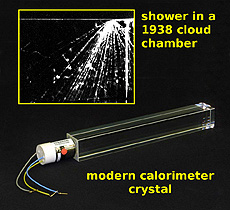Observe neutral particles with this one weird trick
 |
| A shower produces dozens of particles that could be observed individually (inset figure) or collectively in a calorimeter (bottom). |
The previous Physics in a Nutshell introduced tracking, a technique that allows physicists to see the trajectories of individual particles. The biggest limitation of tracking is that only charged particles ionize the medium that forms clouds, bubbles, discharges or digital signals. Neutral particles are invisible to any form of tracking.
Calorimetry, which now complements tracking in most particle physics experiments, takes advantage of a curious effect that was first observed in cloud chambers in the 1930s. Occasionally, a single high-energy particle seemed to split into dozens of low-energy particles. These inexplicable events were called "bursts," "explosions" or "die Stöße." Physicists initially thought they could only be explained by a radical revision of the prevailing quantum theory.
As it turns out, these events are due to two well-understood processes, iterated ad nauseam. Electrons and positrons recoil from atoms of matter to produce photons, and photons in matter split to form electron-positron pairs. Each of these steps doubles the total number of particles, turning a single high-energy particle into many low-energy particles.
This cascading process is now known as a shower. The cycle of charged particles creating neutral particles and neutral particles creating charged particles can be started by either type, making it sensitive to any particle that interacts with matter, including neutral ones. Although the shower process is messy, the final particle energies should add up to the original particle's energy, providing a way to measure the energy of the initial particle — by destroying it.
Modern calorimeters initiate the shower using a heavy material and then measure the energy using ordinary light sensors. To accurately measure the energy of the final photons, this heavy material should also be transparent. Crystals are a common choice, as are lead-infused glass, liquid argon and liquid xenon.
Not all calorimeters are man-made. Neutrinos produce electrons in water or ice, which cascade into showers of electrons, positrons and photons. The IceCube experiment uses a cubic kilometer of Antarctic ice to observe PeV neutrinos — a hundred times more energetic than the LHC's beams. Cosmic rays form showers in the Earth's atmosphere, producing about 4 watts of ultraviolet light and billions of particles. The Pierre Auger Observatory uses sky-facing cameras and 3,000 square kilometers of ground-based detectors to capture both and has measured particles that are a million times more energetic than the LHC's beams.
—Jim Pivarski
|